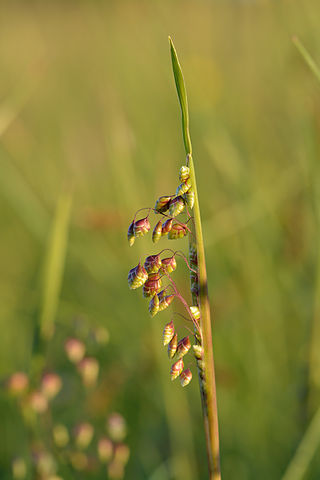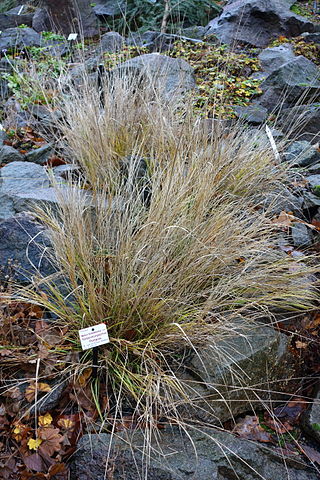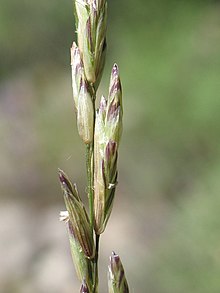
Bromus is a large genus of grasses, classified in its own tribe Bromeae. They are commonly known as bromes, brome grasses, cheat grasses or chess grasses. Estimates in the scientific literature of the number of species have ranged from 100 to 400, but plant taxonomists currently recognize around 160–170 species.

Festuca (fescue) is a genus of flowering plants belonging to the grass family Poaceae. They are evergreen or herbaceous perennial tufted grasses with a height range of 10–200 cm (4–79 in) and a cosmopolitan distribution, occurring on every continent except Antarctica. The genus is closely related to ryegrass (Lolium), and recent evidence from phylogenetic studies using DNA sequencing of plant mitochondrial DNA shows that the genus lacks monophyly. As a result, plant taxonomists have moved several species, including the forage grasses tall fescue and meadow fescue, from the genus Festuca into the genus Lolium, or alternatively into the segregate genus Schedonorus.

The Pooideae are the largest subfamily of the grass family Poaceae, with about 4,000 species in 15 tribes and roughly 200 genera. They include some major cereals such as wheat, barley, oat, rye and many lawn and pasture grasses. They are often referred to as cool-season grasses, because they are distributed in temperate climates. All of them use the C3 photosynthetic pathway.

Glyceria is a widespread genus of grass family common across Eurasia, Australia, North Africa, and the Americas.

Melica ciliata, the hairy melic or silky spike melic, is a species of flowering plant in the grass family Poaceae, native to Europe, north Africa and temperate Asia. It has been introduced to South Australia.

The Stipeae are a tribe of grasses within the subfamily Pooidae, with up to 600 described species.

Melica violacea, is a species of grass in the family Poaceae endemic to Chile.

Melica transsilvanica is a species of grass found in Europe and temperate Asia, including Caucasus and China.
Melica spartinoides, is a species of grass in the family Poaceae that is endemic to the Brazilian state of Santa Catarina.
Melica porteri, known as Porter's melicgrass, is a species of grass that grows in the United States and Mexico. In the US it is found in Arizona, Colorado, Kansas, New Mexico, Texas, Utah, and Iowa.
Melica scaberrima, is a species of grass that can be found in Yunnan, China, Nepal, Pakistan and northern part of India.
Melica onoei is a species of grass found in China, Japan, Korea, Pakistan and Taiwan.
Melica dendroides is a grass species in the family Poaceae that is endemic to southern part of Africa.
Melica eligulata is a species of grass in the family Poaceae. It is native to Afghanistan, Iran, Iraq, Lebanon, Syria, and Turkey.
Melica persica is a species of grass that can be found in Central Asia, India, and in Gansu, Jilin, Sichuan provinces of China.

Melica penicillaris is a species of grass in the Poaceae family. It is endemic to Inner Anatolia, Turkey, where it grows on bushy hills, rocky slopes, limestone surfaces, and in gullies at 1,000–1,800 metres (3,300–5,900 ft) above sea level.
Melica rectiflora is a species of grass in the family Poaceae. It is native to Greece and Crete.

Paniceae is a large tribe of the subfamily Panicoideae in the grasses (Poaceae), the only in the monotypic supertribe Panicodae. It includes roughly 1,500 species in 84 genera, primarily found in tropical and subtropical regions of the world. Paniceae includes species using either of the C4 and C3 photosynthetic pathways, as well as presumably intermediate species. Most of the millets are members of tribe Paniceae.

Ischaemum rugosum, also known as saramollagrass, is a flowering plant belonging to the grass family Poaceae in the genus Ischaemum, and is native to tropical and temperate regions of Asia, growing in marshes and other wet habitats. It is a vigorous annual, and is an invasive species in South America and Madagascar. It reaches heights of up to 1 m and is primarily recognized by the ridged surface of its sessile spikelet’s lower glume. Despite its historic importance as fodder in Asia, the grass has become a major weed in mid-latitude rice paddies throughout Asia and South America.

Rottboellia cochinchinensis is a species of grass known by the common names Itchgrass,Raoul grass, corngrass, Kokoma grass, Guinea-fowl grass, jointed grass, Shamwa grass and Kelly grass. It is a tall, tufted annual grass whose stems (culms) grow up to 3 metres in height with leaf-blades of up to 45 centimetres in length. The species flowers at the apex of culms in the form of spike-like racemes composed of paired spikelets. The common name Itchgrass comes from the bristly (hispid) leaf-sheath which can be irritating to the skin.












